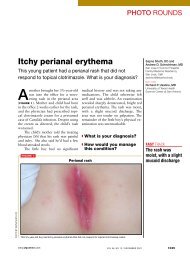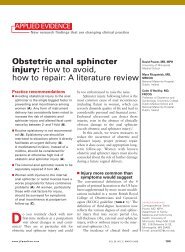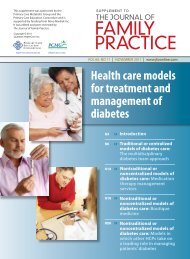Management of morbid obesity - The Journal of Family Practice
Management of morbid obesity - The Journal of Family Practice
Management of morbid obesity - The Journal of Family Practice
You also want an ePaper? Increase the reach of your titles
YUMPU automatically turns print PDFs into web optimized ePapers that Google loves.
ing surgery. Gastric bypass also corrected or alleviated<br />
other co<strong>morbid</strong>ities <strong>of</strong> <strong>morbid</strong> <strong>obesity</strong>, including hypertension,<br />
obstructive sleep apnea, cardiopulmonary failure,<br />
arthritis, and infertility. 7<br />
In the SOS study, incidence <strong>of</strong> diabetes was reduced<br />
32-fold in surgical patients relative to controls at 2<br />
years. At 8 years, there was still a 5-fold reduction in<br />
diabetes incidence. 4 Incidence <strong>of</strong> hypertension was<br />
reduced 2.6-fold in surgical patients relative to controls<br />
at 2 years. However, by 8 years the surgical patients’<br />
blood pressure had reverted to control values despite<br />
maintenance <strong>of</strong> a 16% weight reduction. 4,8,9<br />
Buchwald and colleagues recently conducted a systematic<br />
review <strong>of</strong> published observational and interventional<br />
trials involving bariatric surgery. 10 A total <strong>of</strong> 134<br />
studies (5 randomized controlled trials, 28 nonrandomized<br />
controlled trials or series with comparison groups,<br />
and 101 uncontrolled case series) that included 22,094<br />
patients were analyzed to determine the impact <strong>of</strong> specific<br />
bariatric surgical procedures on weight loss, operative<br />
mortality outcome, and 4 <strong>obesity</strong> co<strong>morbid</strong>ities<br />
(diabetes, hyperlipidemia, hypertension, and obstructive<br />
sleep apnea). Results are summarized in Table 1.<br />
For purposes <strong>of</strong> analysis, surgical procedures were<br />
grouped into 5 main categories: (1) gastric banding, (2)<br />
gastric bypass (this category consisted principally <strong>of</strong><br />
Roux-en-Y variations but included all procedures with<br />
a gastric bypass component, such as gastroplasty with<br />
gastric bypass and banding with gastric bypass), (3) gastroplasty,<br />
(4) biliopancreatic diversion or duodenal<br />
switch, and (5) mixed or other. A random-effects model<br />
was used. Weight loss was reported as the mean percentage<br />
<strong>of</strong> excess weight loss; changes in absolute<br />
weight (kg), body mass index (BMI), and percentage <strong>of</strong><br />
initial weight were also reported where appropriate.<br />
<strong>The</strong> baseline mean BMI for 16,944 patients was<br />
46.9 kg/m 2 (range, 32.3-68.8). Mean percentage <strong>of</strong><br />
excess weight loss was 61.2% (95% CI, 58.1-64.4) for<br />
all patients. Mean percentage excess weight loss by procedure<br />
was: gastric banding, 47.5%; gastric bypass,<br />
61.6%; gastroplasty, 68.2%; biliopancreatic diversion<br />
or duodenal switch, 70.1%. Operative mortality in the<br />
first 30 days was 0.1% for the purely restrictive procedures,<br />
0.5% for gastric bypass, and 1.1% for biliopancreatic<br />
diversion or duodenal switch.<br />
Diabetes was completely resolved in 76.8% <strong>of</strong><br />
patients and resolved or improved in 86.0%. <strong>The</strong>re<br />
FIGURE 5<br />
THE JOURNAL OF<br />
FAMILY<br />
PRACTICE<br />
Risk <strong>of</strong> mortality after bariatric surgery *<br />
(Kaplan Meier analysis)<br />
Percent surviving<br />
100<br />
90<br />
80<br />
70<br />
60<br />
50<br />
Surgery (n=1,035)<br />
Control (n=5,746)<br />
1 2 3 4 5<br />
Years<br />
* Relative risk vs controls, 0.11 (95% CI, 0.04-0.27)<br />
Adapted from Christou et al. 11<br />
P









